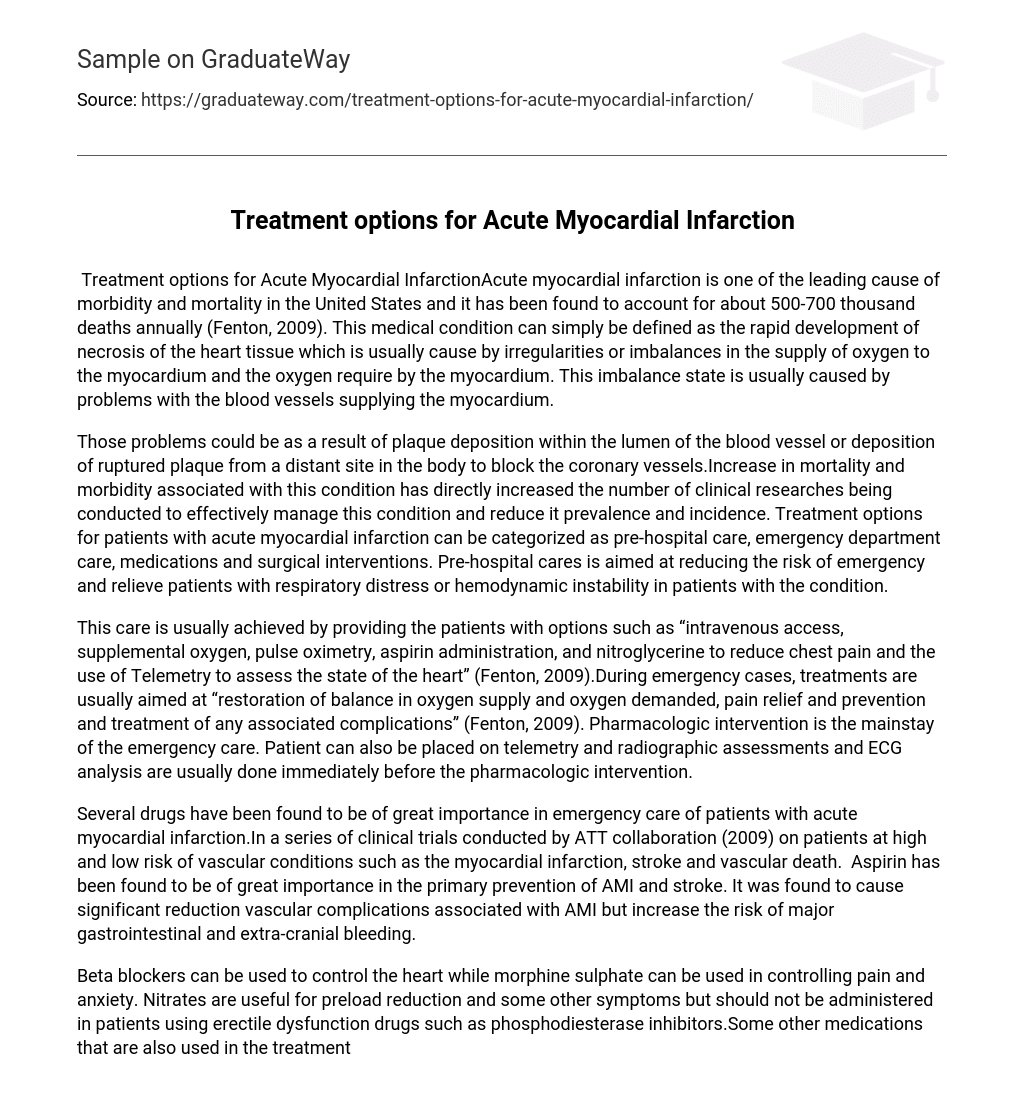Treatment options for Acute Myocardial InfarctionAcute myocardial infarction is one of the leading cause of morbidity and mortality in the United States and it has been found to account for about 500-700 thousand deaths annually (Fenton, 2009). This medical condition can simply be defined as the rapid development of necrosis of the heart tissue which is usually cause by irregularities or imbalances in the supply of oxygen to the myocardium and the oxygen require by the myocardium. This imbalance state is usually caused by problems with the blood vessels supplying the myocardium.
Those problems could be as a result of plaque deposition within the lumen of the blood vessel or deposition of ruptured plaque from a distant site in the body to block the coronary vessels.Increase in mortality and morbidity associated with this condition has directly increased the number of clinical researches being conducted to effectively manage this condition and reduce it prevalence and incidence. Treatment options for patients with acute myocardial infarction can be categorized as pre-hospital care, emergency department care, medications and surgical interventions. Pre-hospital cares is aimed at reducing the risk of emergency and relieve patients with respiratory distress or hemodynamic instability in patients with the condition.
This care is usually achieved by providing the patients with options such as “intravenous access, supplemental oxygen, pulse oximetry, aspirin administration, and nitroglycerine to reduce chest pain and the use of Telemetry to assess the state of the heart” (Fenton, 2009).During emergency cases, treatments are usually aimed at “restoration of balance in oxygen supply and oxygen demanded, pain relief and prevention and treatment of any associated complications” (Fenton, 2009). Pharmacologic intervention is the mainstay of the emergency care. Patient can also be placed on telemetry and radiographic assessments and ECG analysis are usually done immediately before the pharmacologic intervention.
Several drugs have been found to be of great importance in emergency care of patients with acute myocardial infarction.In a series of clinical trials conducted by ATT collaboration (2009) on patients at high and low risk of vascular conditions such as the myocardial infarction, stroke and vascular death. Aspirin has been found to be of great importance in the primary prevention of AMI and stroke. It was found to cause significant reduction vascular complications associated with AMI but increase the risk of major gastrointestinal and extra-cranial bleeding.
Beta blockers can be used to control the heart while morphine sulphate can be used in controlling pain and anxiety. Nitrates are useful for preload reduction and some other symptoms but should not be administered in patients using erectile dysfunction drugs such as phosphodiesterase inhibitors.Some other medications that are also used in the treatment of acute myocardial infarction are the platelet glycoprotein IIb/IIIa-receptor antagonist (used in conjunction with low dose aspirin and unfractionated heparin). This drug combination has been found to improve both early and late outcome in regards to the management.
Heparin is usually indicated in the patients undergoing percutaneous cutaneous intervention. The use of angiotensin converting enzyme inhibitor can also be given to patients with AMI complicated with pulmonary congestion or left ventricular ejection fraction while angiotensin receptor blocker is indicated in patient that contraindicated in patients that can’t tolerate ACE inhibitorReperfusion is one of the recent treatment options in management of patients with acute myocardial infarction. Reperfusion can be administered in form of thrombolytic therapy, percutaneous coronary intervention and bypass surgery. Most patient indicated for this treatment option are patients with suspected cases of acute myocardial infarction or ST segment elevation or bundle branch block because of the presumption that they tend to have occlusive thrombosis of the pericardial arteries.
Thrombolytic therapy is another treatment options that has been found to reduce the mortality rate simply because it usually cause the thrombolysis of the clots blocking the coronary vessels. Thrombolytic therapy is usually contraindicated in unstable angina or for patients with history of cardiogenic shock. The therapy is not always effective in the treatment of myocardial infarction but it can be effective when the therapy is administered within two hours of the acute myocardial episode. The major risk associated with this therapy is that it might increase the risk of intracranial bleeding.
Percutaneous coronary intervention is also known as the coronary angioplasty. It is another therapeutic intervention used to treat occluded myocardial arteries. It is an interventional therapy which aimed at reducing the symptoms of coronary artery disease hence helping to reduce mortality associated with the diseased condition. The most serious risks associated with this intervention are death, stroke, myocardial infarction and aortic dissection.
Cardiogenic shock has been found to complicate several treatment options for patients with acute myocardial infarction. The survival rate of such patients has been found to improve significantly as a result of the application of both medical and supportive approach in conjunction with Percutaneous coronary intervention subsequently improving the patients prognosis ( Dauerman, Harold, Goldberg, ;Robert, 2000).;;ReferencesATT collaboration (2009). “Aspirin in the primary and secondary prevention of vascular disease: collaborative meta-analysis of individual participant data from randomized trials”.
The lancet.Retrieved July 28, 2009 from http://www.thelancet.com/journals/lancet/article/PIIS0140-6736(09)60503-1/fulltextDauerman, Harold, Goldberg, ;Robert, (2000).
“Treatment Options for Acute Myocardial Infarction Complicated by Cardiogenic Shock”. Lippincott Williams ;amp; Wilkins, Inc.Retrieved July 28, 2009 from http://journals.lww.
com/cardiologyinreview/Abstract/2000/08040/Treatment_Options_for_Acute_Myocardial_Infarction.6.aspxFenton, E,.(2009).
“Myocardial Infarction: Treatment ; Medication”. Cardiovascular. eMedicineRetrieved July 28, 2009 from http://emedicine.medscape.com/article/759321-treatment;;





